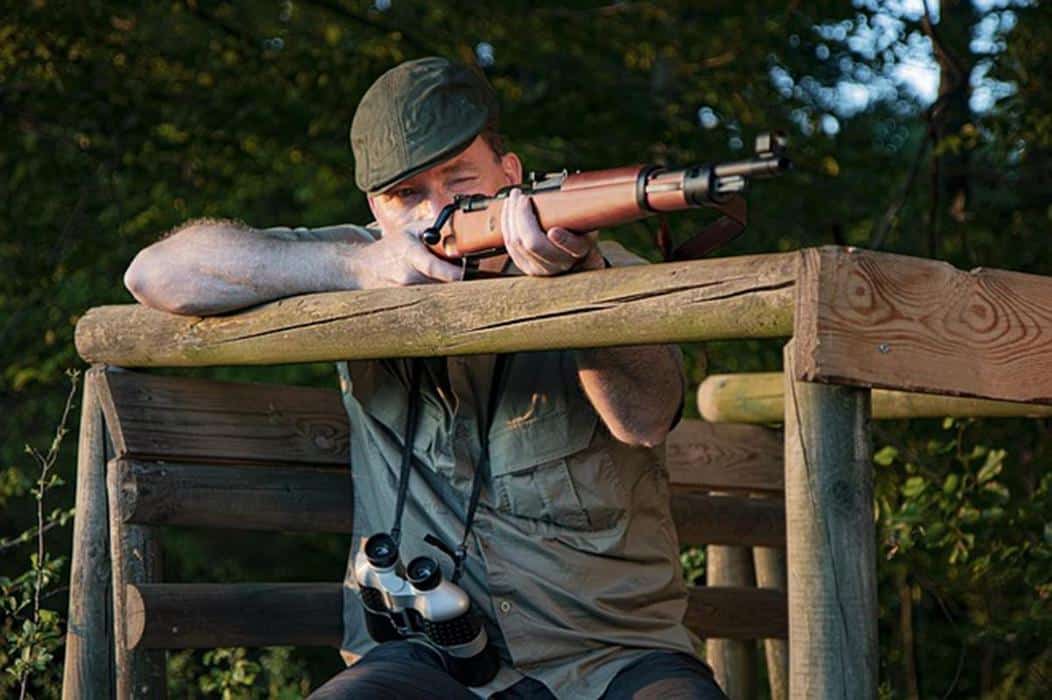 There aren’t that many experiences that are as rewarding as getting a close encounter with a wild animal.
There aren’t that many experiences that are as rewarding as getting a close encounter with a wild animal.
Whether it’s a jaguar, guanaco or capuchin, there’s something fascinating about viewing these creatures in their natural habitat.
To get the most out of this experience, you should invest in a quality pair of binoculars that are designed for this wildlife application.
To make your selection easy, we’ve highlighted the 5 best binoculars for wildlife viewing.
Checkout Best Binoculars For Wildlife Viewing
Contents
Top 5 Best Binoculars For Wildlife
1. Nikon 7577 MONARCH 5 10×42 Binocular
Our favorite pick is the Monarch 5 by Nikon, which strikes the perfect balance between pricing and performance.

Build and design:
Right off the bat, you’ll notice that this set of binoculars is well made. It has a nice rubber-armored body that provides a good grip even in wet conditions.
It also has an exceptional O-ring seal and nitrogen filling to prevent internal fogging. It weighs about 21.2 gram meaning it’s not too heavy to carry to your outdoor exploration trips.
The adjustment knob on this binoculars is easy to reach, enabling you to focus quickly when you need to. Its eyecups use a turn-and-slide mechanism to prevent loss of position or accidental self-adjustment.
Lens:
[They also sport a comfortable eye relief at 18.4mm making them ideal for glass-wearers. The only feature missing in the Nikon 7577 MONARCH 5 is a tripod mount. Unfortunately, this means you have to hold the binoculars the entire time you’re using them.]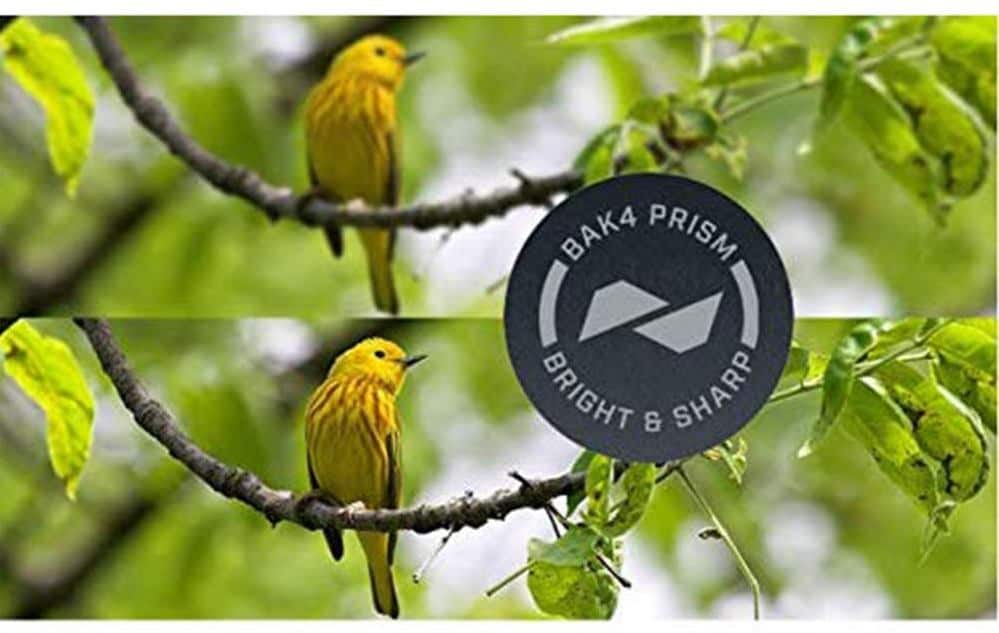
The view you get using this binocular is pretty sharp and clear. This is made possible by the phase-correction coating and fully multi-coated lenses. At its price point, the low-light performance you get from its roof prism is okay but it’s certainly not the best.
With 10x magnification and a 42 mm objective diameter, this binocular is great for wildlife viewing. Its field of view (FOV) is 288 ft at 1000 yards. With such a wide range of view, the Nikon Monarch 5 can double up as elk hunting binoculars
Pros
- Generous eye relief; suitable for glass wearers
- Fully multi-coated lenses and prisms for high-resolution images
- Wide field of view provides a large scope of observing
- Waterproof, fog proof and lightweight construction
Cons
- Not the best for low light viewing conditions
- Lacks a tripod mount
2. Vortex Optics Diamondback 10×42
A slightly pricier option, the Vortex Optics Diamondback is proof that you always get what you pay for.

Build and design:
Like our top pick, these binoculars have a fog proof and waterproof construction. But in this case, the internal anti-fogging ability is achieved by replacing oxygen with argon gas as opposed to nitrogen.
The rubber coating on Vortex Optics makes for easy-to-grip optics equipment while contributing to its waterproof capability. We also like that they have adjustable eyepieces to help you get the perfect view.
Even better, the binoculars come with a central focusing ring. Instead of having to focus each barrel separately, this focus wheel makes an adjustment on both binocular barrels concurrently.

Also, the eyecups on this optics equipment are designed to twist up and down. So even though they have a smaller 15 mm eye relief, the twist design provides a complete field of view even for eyeglass wearers. To be specific, you’ll get a FOV of 330 feet at 1000 yards.
[green – One feature that makes the Diamondback superior to Monarch 5 is the inclusion of a tripod socket. This means they’re compatible with standard tripod adapters, allowing you to mount them easily on a tripod or car window mount. ]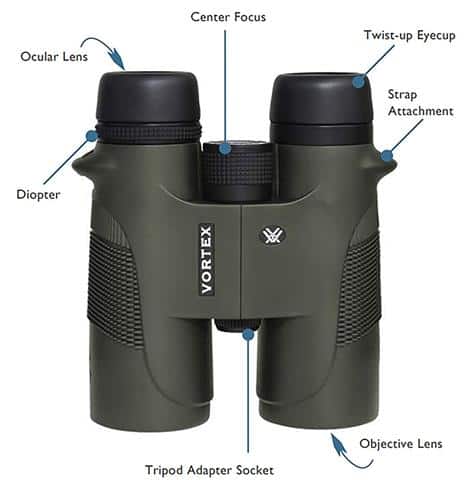
Lens:
When this Best Binoculars for Wildlife comes to the lens, these binoculars are fairly similar to Monarch 5. They have fully multi-coated lenses and phase correction roof prism that boost resolution and contrast.
The magnification specifications are also similar at 10x magnification power and a 42 mm objective lens. With all these features, you’re guaranteed stellar images whether you’re viewing wildlife in high or low light conditions.
Pros
- The user-friendly central focus wheel
- Tripod adaptable
- Adjustable eyecups for a comfortable viewing
- High-resolution images thanks to multi-coated optics and phase-corrected prisms
- Wider field of view at 330 ft./1000 yards
Cons
- Expensive
3. Bushnell H2O Waterproof/Fogproof Binocular
If you’re looking for a set of binoculars that not only works well but also has nice aesthetics, the Bushnell H2O is a superb choice.

Build and design:
They come in a beautiful black shade with a rubber casing, which serves two functions. First, it provides a non-slip grip even if you’re wearing gloves. Second, it protects the optics equipment in the event of a fall or other kind of impact.
Looks aside, the H2O has cutting-edge technology under the hood. With the o-ring seals and nitrogen purging, you don’t have to worry about your binoculars getting damaged by moisture or fog.
These binoculars are also fitted with twist-up eyecups, which provide an excellent view of the wildlife from miles away.
The twist-up design also prevents extraneous light and makes it easy for eyeglass wearers to observe. To that regard, the binoculars have a 17 mm eye relief and FOV of 305 feet per 1000 yards.
The only glitch of the binocular’s design is the weight. While similar 10×42 mm binoculars are light, the Bushnell tips the scales at 27 ounces.
This can feel quite heavy, especially if you’re holding them for an extended period. Luckily, it’s compatible with a standard size tripod which provides easier mounting.
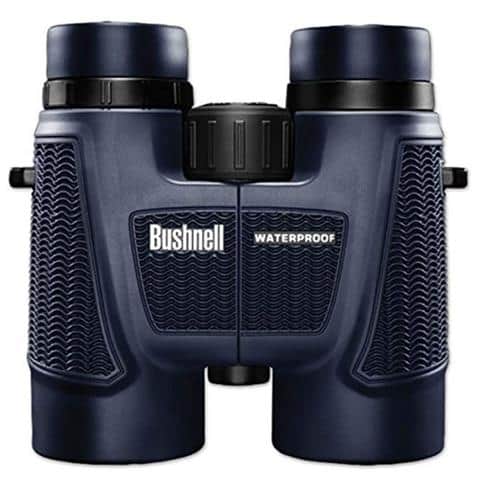
Lens:
Another noteworthy feature is the focus wheel that is centrally located to provide seamless adjustment.
[blue – While all these features make the Bushnell H2O one of the best binoculars for animal watching, what truly sets it apart is the BAK-4 prisms.When comparing different types of Porro prisms, the BAK-4 prisms are the cream of the crop. These are constructed using superior optical glass, which results in razor-sharp and highly-detailed images. ]
Furthermore, the lenses are multi-coated- a feature that minimizes light loss so as to improve the resolution of images.
This makes the optics device ideal for nighttime or low-light conditions. With a magnification power of 10x and an objective diameter of 42 mm, this unit will be a great addition to your exploration gear.

Pros
- Comes at a mid-range price
- Bak-4 prisms and multi-coated lens provide clear images
- Compatible with tripod
- Fogproof and waterproof
- Great performance in low-light viewing
Cons
- Heavy and bulky
4. Nikon Aculon A211 10×42 Binoculars
When choosing birding binoculars, it’s possible to get a quality pair of binoculars for your expeditions without breaking your bank. That is if you invest in low-priced models like the Nikon Aculon A211 binoculars.
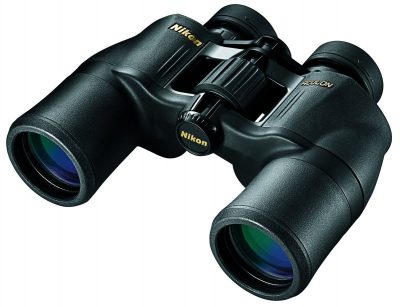
Build and design:
Despite the affordable pricing, this set has a rugged build, making it ideal for wildlife observation.
More specifically, it has an all-weather construction meaning you can comfortably use it in wet conditions. The binoculars are waterproof, fog-proof and have a full rubber armoring.
Nikon A211 is fitted with an enormous, slip-resistant center focus wheel. This makes it easy to manipulate whether you’re wearing gloves or using the gadget in wet conditions.
[However, there are two areas where the Aculon falls short. One is in weight. The device weighs about 26.8 ounces, which is on the heavier side of the weight spectrum. This poses a challenge when handling it in the field. Fortunately, they can be used with a tripod which allows hands-free operation.Secondly, the binoculars have an eye relief of just 11.6 mm. This means they’re not the best for eyeglass wearers. The only saving grace is that they’re equipped with twist-up eyecups, which enable you to adjust to the right eyecup extension for comfortable viewing.]

Lens:
On the plus side, the binoculars don’t disappoint when it comes to optical technology. They sport a multi-layer coated lens that enhances the brightness and contrast of images.
They also feature aspherical eyepiece lenses. The purpose of these is to prevent the distortion of images even on the lens periphery.
As such, the 10×42 binoculars offer a generous field of view of about 314 feet at 1000 yards. Besides, they have the BAK 4 prisms that produce crisp, highly-detailed images.
The binoculars sport a sizeable objective objective lens, which facilitates sufficient collection and transmission of light. This in turn, results in bright images even in low light conditions.
Pros
- Affordable
- Wide field of view
- Includes a tripod socket
- Multicoated lenses and BaK 4 prisms to improve resolution
Cons
- Heavy
- Short eye relief; hence not suitable for those wearing eyeglasses
5. Celestron Nature DX 8×42 Binocular
Even though most of the binoculars we’ve recommended have a magnification strength of 10x, 8x is also fit for this application. Among the 8x models, the Celestron Nature DX is one of the best. It has a good selection of features at a mid-range price point.
Build and design:
When you first hold this gadget in your hands, you’ll notice that it’s incredibly light. It weighs just 22.2 ounces, making it one of the lightest binoculars in our review.
Better yet, the Celestron is designed with the outdoor explorer in mind. This is why it’s completely waterproof with a rubber armoring for a non-slip grip. Adjusting the Celestron DX is not difficult as the focus knob glides back and forth with great ease.
Like most binoculars, this binoculars set has twist-up eyecups. These provide ample space and comfort for viewing. Its eye relief stands at 17.5 mm, making it perfect for eyeglass wearers.
Plus, it’s advertised as tripod adaptable, meaning it can be used hands-free.

Lens:
When it comes to optics technology, Celestron Nature DX uses fully multi-coated lenses that enhance light transmission. Factor in the BAK-4 prisms and you have decent image contrast along with good resolution to provide crystal-clear images.
The fully multi-coated lenses and phase coated prisms also make the binoculars capable of producing clear images in low-light conditions. In normal lighting conditions, the optics device provides a field of view of 388 ft. at 1000 yards.
One thing that makes the DX stand out is the incorporation of lens covers. These serve to shield the lens from accidental damage, which can occur when using the binoculars in rough terrain.
Pros
- Rubber-armored for a comfortable grip and water-resistant construction
- Optics are fully multi-coated to produce sharp images
- Generous eye relief for eyeglass wearers
- Lens covers to prevent potential damage
Cons
- Occasional blurring when you want to view images at the full magnification level
Best Binoculars For Wildlife Buying Guide
Magnification
People tend to assume that higher magnification is always better. But this couldn’t be further from the truth. A higher magnification results in:
- Reduced brightness
- Decreased depth of field
- Reduced field of view
- Unsteady images
The ideal magnification for wildlife binoculars is between 8x and 10x. Those with 12x magnification and higher will cause the issues mentioned above.
Objective lens
The rule of thumb here is that the larger the objective lens, the brighter your images will appear. But as with most factors, this also comes with trade-offs. For instance, the binoculars are heavier; hence more difficult to carry or handle in the field.
The secret is to find a pair of binoculars that strikes a good balance between low-light performance and portability. For wildlife observers, this sweet spot is a 42 mm– a full-size unit- or 32 mm – for a mid-size binocular.
Field of view
Essentially, this metric determines the scope of land you’ll be able to see at a glance. The distance is measured 1000 yards from where you’re standing.
It’s a no-brainer that you should invest in a binocular with a wide field of view. This way, you’ll have a spectacular view of the wild animals regardless of how far you will be.
7 FAQ about the “Best Binoculars for Wildlife”:
1. What are the best binoculars for wildlife viewing?
- Answer: The best binoculars for wildlife viewing typically have a combination of features such as a high magnification level, large objective lens diameter, waterproof and fogproof construction, and high-quality optics. Brands like Nikon, Vortex, Swarovski, and Zeiss are often recommended for their excellent wildlife binoculars.
2. What magnification is ideal for wildlife observation?
- Answer: Magnification between 8x and 10x is generally considered ideal for wildlife observation. Higher magnification might result in a narrower field of view and shakiness due to hand tremors, while lower magnification might not provide enough detail for distant animals.
3. How do I choose the right objective lens diameter for wildlife binoculars?
- Answer: The objective lens diameter affects the amount of light entering the binoculars, which impacts image brightness and low-light performance. For wildlife viewing, an objective lens diameter of around 42mm to 50mm is recommended for a good balance between brightness and portability.
4. Are compact binoculars suitable for wildlife watching?
- Answer: Compact binoculars are portable but might sacrifice some light-gathering ability and image quality compared to larger models. They can be suitable for daytime wildlife viewing in well-lit environments, but larger binoculars with bigger objective lenses tend to offer better performance in low-light conditions.
5. What features should I look for in wildlife binoculars?
- Answer: Key features to consider include waterproof and fogproof construction to withstand outdoor conditions, phase-coated prisms for better color and contrast, fully multi-coated lenses for optimal light transmission, a wide field of view, and comfortable eye relief for extended use.
6. Are image stabilization binoculars worth it for wildlife viewing?
- Answer: Image stabilization binoculars can help reduce hand tremors and provide a more stable image, which can be especially useful at higher magnifications. They are worth considering if you plan to do a lot of wildlife viewing without using a tripod, but they tend to be more expensive.
7. What’s a reasonable budget for high-quality wildlife binoculars?
- Answer: High-quality wildlife binoculars can range from around $200 to $1000 or more, depending on the brand, features, and optical quality. It’s often a good idea to invest in the best binoculars you can afford, as better optics will enhance your wildlife viewing experience.
Remember that individual preferences may vary, and it’s important to consider factors such as comfort, weight, and intended use when choosing the best binoculars for your wildlife observation needs.
Final Verdict
If you’re planning a wildlife tour, one essential equipment that you should invest in is a set of binoculars. Our most recommended “Best Binoculars for Wildlife Viewing” is the Nikon 7577 MONARCH 5 10×42 Binocular that balances pricing and features really well. And, if you’re looking for a high-end optics gadget, the Vortex Optics Diamondback is also an excellent option.



